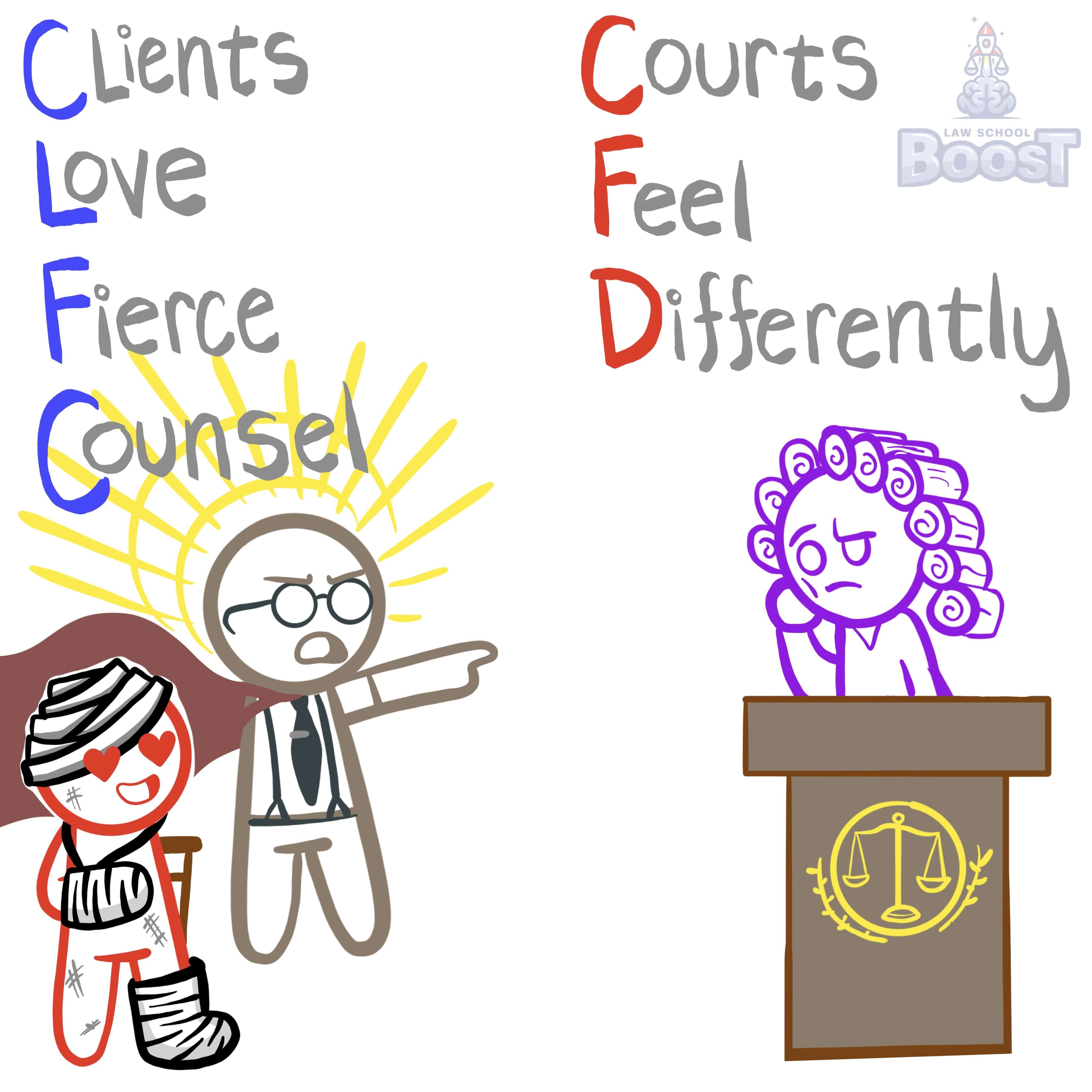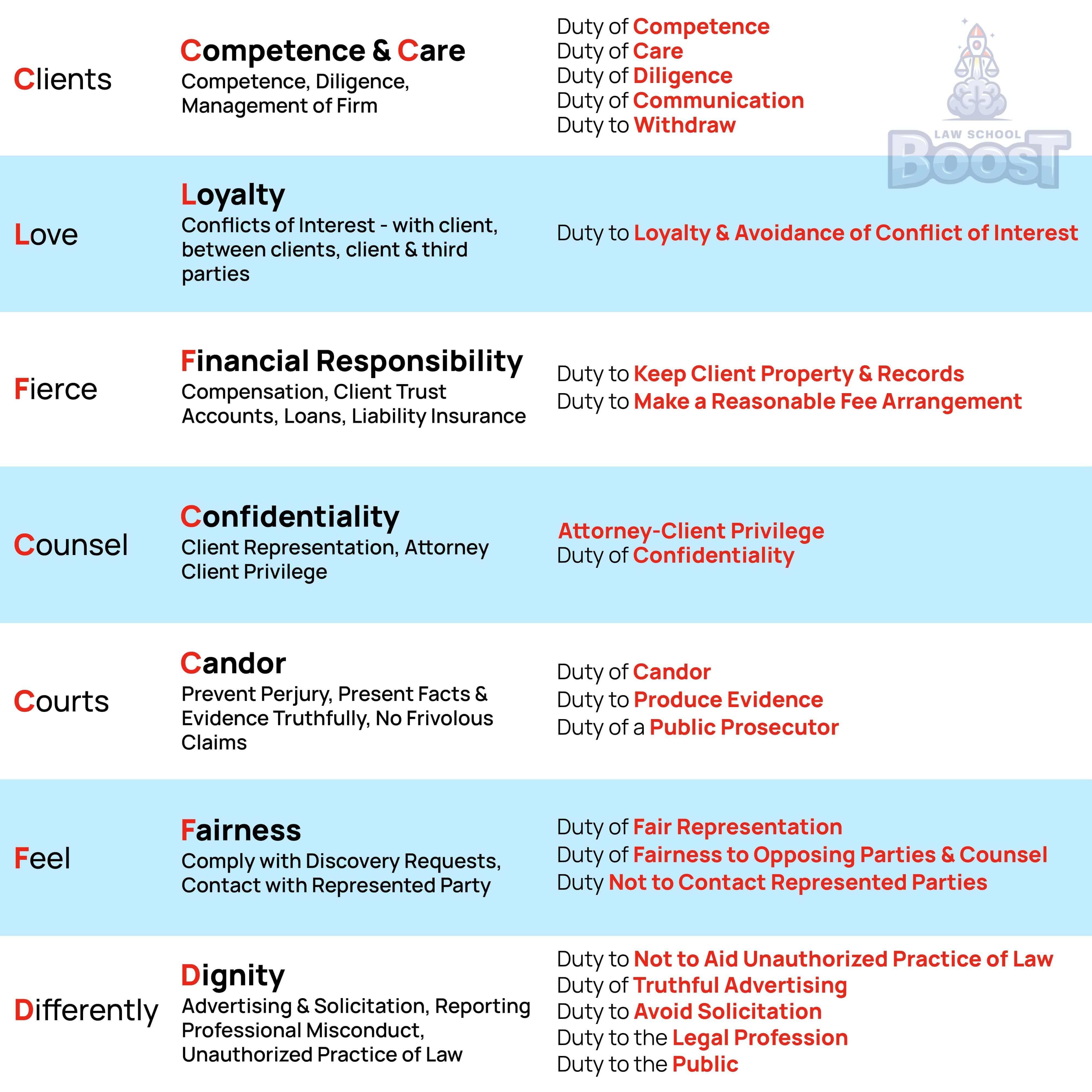‼️
Prof Responsibility • Financial Duties
PR#011
Legal Definition
Under the ABA, fees must be reasonable. To determine what is "reasonable," Rule 1.5(a) considers the following factors:
(1) The difficulty and novelty of the matter.
(2) The prevailing fees in the locale.
(3) How much time and business a lawyer must give up to take the case.
(4) Whether the fee is fixed or contingent.
(5) Time limitations imposed by the client or the circumstances.
(6) The amount involved and the results obtained.
(7) The experience, reputation, and ability of the lawyer performing the services.
(1) The difficulty and novelty of the matter.
(2) The prevailing fees in the locale.
(3) How much time and business a lawyer must give up to take the case.
(4) Whether the fee is fixed or contingent.
(5) Time limitations imposed by the client or the circumstances.
(6) The amount involved and the results obtained.
(7) The experience, reputation, and ability of the lawyer performing the services.
Plain English Explanation
The rule on reasonable attorney fees recognizes that what's considered "reasonable" can vary based on the specific circumstances of each case. Rather than setting a fixed standard, the rule provides several factors for determining if a fee is reasonable:
(1) Difficulty and novelty: A more complex or unusual case may justify higher fees, as it requires greater skill and effort from the lawyer.
(2) Local rates: What's reasonable in New York City may be different from what's reasonable in a small town. The rule acknowledges these geographic differences.
(3) Opportunity cost: If taking on a case means a lawyer must turn down other work, that can be factored into the fee.
(4) Fee structure: Whether the fee is fixed or contingent can affect its reasonableness. A contingent fee may be higher to account for the risk the lawyer takes on.
(5) Time constraints: Rush jobs or matters with tight deadlines may warrant higher fees.
(6) Amount at stake and results: A case involving millions of dollars may justify higher fees than a small claims matter. The outcome achieved can also be considered.
(7) Lawyer's qualifications: A highly experienced specialist may be able to charge more than a new graduate for the same type of case.
(1) Difficulty and novelty: A more complex or unusual case may justify higher fees, as it requires greater skill and effort from the lawyer.
(2) Local rates: What's reasonable in New York City may be different from what's reasonable in a small town. The rule acknowledges these geographic differences.
(3) Opportunity cost: If taking on a case means a lawyer must turn down other work, that can be factored into the fee.
(4) Fee structure: Whether the fee is fixed or contingent can affect its reasonableness. A contingent fee may be higher to account for the risk the lawyer takes on.
(5) Time constraints: Rush jobs or matters with tight deadlines may warrant higher fees.
(6) Amount at stake and results: A case involving millions of dollars may justify higher fees than a small claims matter. The outcome achieved can also be considered.
(7) Lawyer's qualifications: A highly experienced specialist may be able to charge more than a new graduate for the same type of case.
Hypothetical
Hypo 1: Bob, a newly licensed attorney, takes on Sam's complex patent infringement case. Bob charges Sam $1,000 per hour, which is twice the rate of even the most experienced patent attorneys in their small Midwestern town. Sam agrees, believing Bob must be exceptionally skilled to charge such a high rate. After losing the case, Sam discovers Bob's lack of experience and feels cheated. Result: Bob's fee is likely unreasonable under Rule 1.5(a). The rate significantly exceeds the local standard for even experienced attorneys, and Bob's lack of experience and the case outcome don't justify such a high fee. Factors (2), (6), and (7) weigh heavily against Bob here. While the complexity of patent law might justify higher fees under factor (1), Bob's inexperience negates this.
Hypo 2: Sam, a small business owner, hires Bob to handle a straightforward contract dispute. Bob, an experienced business litigator, charges his usual rate of $400 per hour. The case unexpectedly becomes more complex when the opposing party files multiple motions, requiring Bob to work nights and weekends, canceling other client meetings. Bob increases his rate to $500 per hour for the extra work. Result: Bob's fee increase is likely reasonable under Rule 1.5(a). Factors (1), (3), and (5) support the increase. The case became more difficult and time-consuming than anticipated, requiring Bob to sacrifice other work. As long as Bob's new rate is still in line with local standards for complex business litigation (factor 2) and Bob's experience (factor 7), the increase should be justifiable.
Hypo 3: Sam hires Bob on a contingency basis for a personal injury case. Bob typically charges a 33% contingency fee but increases it to 50% when he learns the defendant is a large corporation known for dragging out litigation. The case settles quickly for $100,000, with Bob doing minimal work. Result: Despite the quick resolution, Bob's 50% contingency fee might still be reasonable under Rule 1.5(a). Factor (4) explicitly considers whether the fee is contingent. The higher percentage could be justified by factors (1) and (3) - the anticipated difficulty and time commitment of facing a notoriously difficult opponent. However, the quick settlement and minimal work actually required (factors 5 and 6) might weigh against the fee's reasonableness. The local standard for contingency fees (factor 2) would also be important in determining if 50% is excessive.
Hypo 4: Sam, a wealthy entrepreneur, hires Bob to draft a simple will. Bob, knowing Sam's wealth, charges $10,000 for three hours of work. When Sam questions the fee, Bob justifies it by saying, "You can afford it, and I have a great reputation." Result: This fee is likely unreasonable under Rule 1.5(a). While factor (7) considers the lawyer's reputation, it doesn't justify such an inflated fee for a simple task. The fee doesn't align with the difficulty of the work (factor 1), time spent (factor 3), or likely local standards (factor 2). Bob seems to be basing his fee primarily on Sam's ability to pay, which isn't a factor listed in Rule 1.5(a). This fee would likely be considered excessive and unreasonable.
Hypo 5: Sam asks Bob to review a lease agreement. Bob charges Sam his standard hourly rate of $300. Sam later complains that the fee is unreasonable because his friend, who is also a lawyer, would have done it for free. Result: This situation doesn't involve the application of Rule 1.5(a) on reasonable fees. Bob's standard rate for a routine task doesn't trigger the rule's analysis. The fact that Sam's friend would have done the work for free doesn't make Bob's fee unreasonable. The rule is about preventing excessive fees, not requiring lawyers to match the lowest possible price or work for free. As long as Bob's rate is in line with local standards and his experience, it's likely reasonable, regardless of what other arrangements Sam might have made.
Hypo 2: Sam, a small business owner, hires Bob to handle a straightforward contract dispute. Bob, an experienced business litigator, charges his usual rate of $400 per hour. The case unexpectedly becomes more complex when the opposing party files multiple motions, requiring Bob to work nights and weekends, canceling other client meetings. Bob increases his rate to $500 per hour for the extra work. Result: Bob's fee increase is likely reasonable under Rule 1.5(a). Factors (1), (3), and (5) support the increase. The case became more difficult and time-consuming than anticipated, requiring Bob to sacrifice other work. As long as Bob's new rate is still in line with local standards for complex business litigation (factor 2) and Bob's experience (factor 7), the increase should be justifiable.
Hypo 3: Sam hires Bob on a contingency basis for a personal injury case. Bob typically charges a 33% contingency fee but increases it to 50% when he learns the defendant is a large corporation known for dragging out litigation. The case settles quickly for $100,000, with Bob doing minimal work. Result: Despite the quick resolution, Bob's 50% contingency fee might still be reasonable under Rule 1.5(a). Factor (4) explicitly considers whether the fee is contingent. The higher percentage could be justified by factors (1) and (3) - the anticipated difficulty and time commitment of facing a notoriously difficult opponent. However, the quick settlement and minimal work actually required (factors 5 and 6) might weigh against the fee's reasonableness. The local standard for contingency fees (factor 2) would also be important in determining if 50% is excessive.
Hypo 4: Sam, a wealthy entrepreneur, hires Bob to draft a simple will. Bob, knowing Sam's wealth, charges $10,000 for three hours of work. When Sam questions the fee, Bob justifies it by saying, "You can afford it, and I have a great reputation." Result: This fee is likely unreasonable under Rule 1.5(a). While factor (7) considers the lawyer's reputation, it doesn't justify such an inflated fee for a simple task. The fee doesn't align with the difficulty of the work (factor 1), time spent (factor 3), or likely local standards (factor 2). Bob seems to be basing his fee primarily on Sam's ability to pay, which isn't a factor listed in Rule 1.5(a). This fee would likely be considered excessive and unreasonable.
Hypo 5: Sam asks Bob to review a lease agreement. Bob charges Sam his standard hourly rate of $300. Sam later complains that the fee is unreasonable because his friend, who is also a lawyer, would have done it for free. Result: This situation doesn't involve the application of Rule 1.5(a) on reasonable fees. Bob's standard rate for a routine task doesn't trigger the rule's analysis. The fact that Sam's friend would have done the work for free doesn't make Bob's fee unreasonable. The rule is about preventing excessive fees, not requiring lawyers to match the lowest possible price or work for free. As long as Bob's rate is in line with local standards and his experience, it's likely reasonable, regardless of what other arrangements Sam might have made.
Visual Aids



Related Concepts
How and when must a lawyer determine fee arrangements with a new client?
How does California rule on fee splitting differ from the ABA?
How may a contingent fee be calculated?
In California, how and when must a lawyer determine fee arrangements with a new client?
In California, what constitutes "reasonable fees"?
Under the ABA, which types of cases are prohibited from contingent fee arrangements?
What is a contingency fee?
What is required to fee split with another lawyer not in their firm?
What must a contingent fee offer warn the client of, and how?


